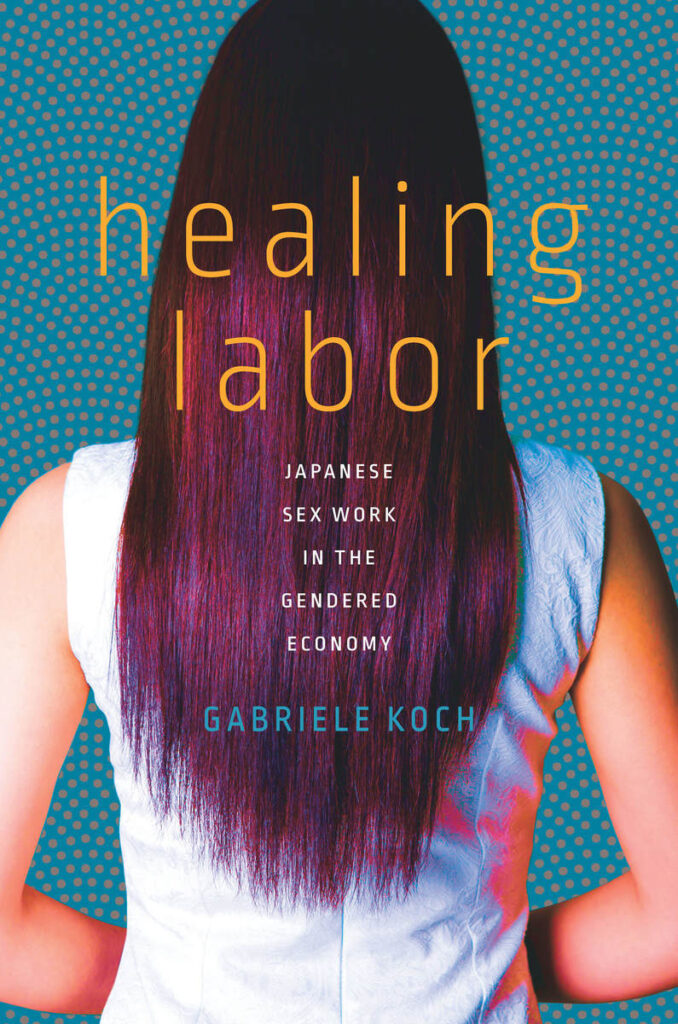JQ Magazine: Book Review — ‘Healing Labor’

By Rashaad Jorden (Yamagata–ken, 2008-10; Kochi-ken, 2018-2020) for JQ magazine. A former head of JETAA Philadelphia’s Sub–Chapter, Rashaad is a graduate of Leeds Beckett University with a master’s degree in responsible tourism management. For more on his life abroad and enthusiasm for taiko drumming, visit his blog at www.gettingpounded.wordpress.com.
Modern Japan is a huge market for sex.
That statement probably isn’t surprising to those who have spent a night out in certain parts of Tokyo. But this is a reality for people who devote a lot of time to sex work.
Gabriele Koch tackles that statement and more in her examination of Japanese sex workers in Healing Labor: Japanese Sex Work in the Gendered Economy. Koch, an assistant professor of anthropology at Yale-NUS College, conducted 21 months of ethnographic fieldwork in Tokyo from 2008 to 2013 (she also gathered information from additional trips to the metropolis in 2016 and 2017). During her fieldwork, the author explored sites connected to the sex industry as well as diverse groups of people involved in it. Koch would seemingly have had plenty of opportunities to do so: according to research she cited in the book, roughly 22,000 legal sex industry businesses are in operation in Japan.
The information in Healing Labor (a term used to illustrate the view many sex workers have of the reparative aspects of their care since it’s ostensibly vital to any success in the male-gendered economy) is largely qualitative, so Koch doesn’t heavily rely on statistics. But she does use numbers to illustrate the risks for sex workers at Tokyo deriheru (an escort business in which a sex worker is sent to a hotel, rental room or private residence): mainly, in that instance, the relatively low condom use by male patrons.
The world of sex work is largely conveyed to readers via interviews and the author’s observations. Koch once participated in a training session for new employees of a sexual message business, where she learned about the ideal encounter between a sex worker and a customer. Being a successful sex worker require detailed attention to the customer’s desires and feelings, and the book features quotes from those in the industry who scoff at the thought that anyone can do sex work. The author notes that according to professional sex workers, women lacking technique, empathy or interpersonal skills will be unable to attract a regular clientele.
Koch excels at obtaining information from her interlocutors, and this information makes Healing Labor a fascinating glimpse into sex life in Japan. She definitely knows how to ask the right questions. One sex worker she interviewed stated five different forms of attentive empathy (mekubari, kikubari, kokorokubari, kizukai, and kororozukai) that are crucial in providing care. It shouldn’t be surprising there are very Japanese aspects to the sex industry; an important point that needs to be addressed in why women find sex work appealing. Koch thoroughly details the benefits many women have found in sex work, such as the ability to earn a decent amount in a short period of time and flexibility (many women in the sex industry find they can set their own schedule). Indeed, women who have earned a substantial amount of money have been able to partake in activities that were previously inaccessible to them.
Of course, one would think that in a seemingly dangerous field (especially as sexual activity with strangers takes place), exploitation occurs. Koch doesn’t shy away from addressing dark aspects of her research. She includes a paragraph published by a Tokyo-based anti-human trafficking organization that states “most victims of human trafficking are forced to work in the sex industry.” In Japan, there’s a misconception that only foreign migrant women can be the victims of trafficking. However, the book reveals that is far from the case. In addition, Koch outlines why it’s difficult for sex workers, due to being independent contractors and not officially “employees,” to fight for improved conditions. The issue of child prostitution is also not shoved aside.
Although Healing Labor addresses a serious topic and is written by an academic, it is not a difficult read. While the book’s introduction is rather lengthy, each of the six chapters focuses on a different aspect of the world of sex work. Koch also makes her work easy to digest by including a “conclusion” (which is more or less a summary) at the end of each chapter.
While there is so much more that could be told about sex work in Japan (it would be interesting to discover if the scene is different in other major cities as well as sex work outside of a cisheteronormative environment), Healing Labor reveals that there’s more than meets the eye for those who have spent a night out in a seedy Japanese neighborhood.
For more information on Healing Labor, click here.
For more JQ magazine book reviews, click here.


Comments are closed.